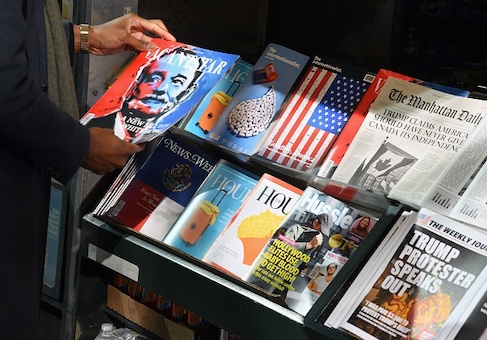Freedom of the press is under attack, and President Donald Trump is to blame. So goes the media narrative.
Mark Levin accepts the premise that freedom of the press is at risk, but places the locus of blame on the media itself. His new book Unfreedom of the Press takes the media to task for "destroying freedom of the press from within."
First and foremost, the media has a credibility problem, as Levin points out. A 2018 Knight Foundation-Gallup survey found Americans believe the media has an important role to play in democracy, but "they don’t see that role being fulfilled and less than half (44 percent) can name an objective news source."
By making the case that the threat to the media does not come from without, Levin reminds readers that for rights and freedoms to be robust, they demand responsibility on the part of those exercising them.
And the modern press has demonstrated a severe dereliction of duty. Levin's chapter highlighting historian Daniel Boorstin's consideration of "pseudo-events" is particularly illuminating on this point.
Boorstin observes that the rise of the round-the-clock news cycle demanded reporters fill more space at a quicker pace. Levin quotes Boorstin's argument that "the test of a Washington reporter is seldom his skill at precise dramatic reporting, but more often his adeptness at dark intimation."
One could argue that the media has surpassed "intimation," especially in the context of special counsel Robert Mueller's investigation into possible Russian collusion in the 2016 election.
In February, an MSNBC panel compared Trump to Benedict Arnold while discussing the collusion investigation. Around the same time, an MSNBC contributor labeled Trump a "dictator" who was "owned by Putin," and called for people to take to the streets.
The rapid-fire 24-hour news cycle on display during the Mueller investigation also led to outright falsehoods.
The New York Post's Sohrab Ahmari highlights "ten things the media got wrong," including BuzzFeed’s whopper that the president supposedly told his former personal attorney Michael Cohen to lie to Congress about talks to build a Trump Tower in Moscow (he didn't, according to Mueller).
When a reporter can't find a story, Boorstin writes, "he must give us a 'think piece'—an embroidering of well-known facts, or speculation about startling things to come." This "synthetic novelty which has flooded our experience" is what he labels "pseudo-events."
The Russian collusion story, writes Levin, "turned out to be the biggest pseudo-event and news scam perpetuated against the American people by the Democratic party-press in modern times."
A party-press is not a new phenomenon. American media in the first half of the 19th century was openly partisan, and politics captivated the republic. Levin cites historian Harold Holzer on this point:
"Kept in a perpetual state of political arousal by journalism, and further stimulated by election cycles that drew voters to the polls several times each year…the overwhelming majority regarded politics with a fervor that approached religious awakening," Holzer writes.
The 19th century's party-press was, however, almost evenly split between parties, unlike today. And the modern press's unchecked Democratic partisanship leads it to pursue what confirms partisan narratives instead of truth.
Thus, the press in the past year has unquestioningly parroted figures such as adult film actress Stormy Daniels's attorney Michael Avenatti, who was given $175 million in earned media from March to May 2018—which doesn't include his ubiquitous media presence during Brett Kavanaugh's confirmation process.
Avenatti was charged last month with embezzling millions from clients. His client, Daniels, saw her lawsuit against the president dismissed in March. Avenatti and his other client, Kavanaugh accuser Julie Swetnick, were referred to the Department of Justice in October for possible criminal charges after Swetnick backed off of claims made in a sworn statement.
Levin shows a greater appreciation for the press of the Revolutionary era, arguing that the pamphleteers and newspapermen of the period "in many ways…fashioned the case for liberty, independence, and representative government."
They were, he argues, "truly brave souls—they were patriots, pioneers, and entrepreneurs, both leaders of and reflective of the colonists and their commitment to liberty and revolution."
Turning back to the book's broader argument, Levin modestly insists he is trying to "jump-start a long-overdue and hopefully productive dialogue" about how to address the media's declining role "as a bulwark of liberty."
Lying within the book is an important contribution to that dialogue, and towards considering what constitutes, and sustains, a free press.
The media has cultivated a narrative whereby it is supposedly protecting the First Amendment against the nefarious wiles of Mr. Trump. In doing so, it has shed any sense of its own obligations for upholding a vigorous, free press.
Perhaps the most salient point to be drawn from this book, then, is that a free press does not lie merely in a lack of external interference; rather, a free press requires a media which recognizes its obligation to credibility and the pursuit of truth.
The media could also take a lesson from the publishers of the Founding era, who inspired the trust and unity of the people by their commitment to uplifting the nascent American republic.
